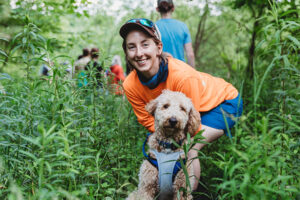Team member Mak Estill joined the Conservancy six months ago as the Land Protection Coordinator. Here, she reflects back on the journey that brought her to the Conservancy and her first six months on the job.

Mak and her dog, Sunny, on a hike at Conoy Wetlands Nature Preserve.
It’s a winding road that led me to the Lancaster Conservancy. After finishing my undergraduate degree from the University of Utah, studying a variety of environmental sciences and nearly all-topics related to environmental sustainability, I landed a job with the Oregon State Park Service helping with environmental interpretive work. I moved to the rugged and remote area of Joseph, Oregon, where the steep canyons of the desert meet the steep slopes of the Wallowa Mountains.
My first week driving in my new town, I glanced over at a business titled the Wallowa Land Trust, with their business logo being suggestive of environmental work. I went home and immediately looked them up, and for the first time in my life discovered what a “land trust” was.
Suddenly, I was washed over with feelings of exhilaration as well as confusion and annoyance. I was confused as to why, as a college student that had been studying conservation for many years, I had never once learned about land trusts as a viable option for addressing critical community issues.
Land trusts are amazing hubs for community, collaboration and grassroot efforts that are place-based. They coordinate and connect landscapes, provide opportunities to the public, materialize public values, and create attractive places to work, live and explore. Most importantly, I find land trusts to be extremely American, highlighting a bottom up, participatory and democratic approach to enriching the communities we care about.
As I continued to move through the waves of my life over the next few years that followed, I kept my interest in land trusts in the back of my mind. Eventually, I decided to pursue a master’s degree in Nonprofit Management at the University of Oregon, with the intent of spending my career working with the global land trust community.
As the Land Protection Coordinator, I work closely with our Senior Vice President of Land Protection and General Councel, Kate Gonick, to support land transactions for the Conservancy. Kate vets and negotiates land transactions based on our accreditation process, while I map, research, and support these transactions in a variety of ways. Each land transaction requires its own unique support from Kate and I, so our tasks are consistently consistent and consistently inconsistent.
“Most importantly, I find land trusts to be extremely American, highlighting a bottom up, participatory and democratic approach to enriching the communities we care about.”
The Conservancy is 100% busy, 100% of the time. None of our work is meaningless “busy” work, it is all strategic, prioritized and meaningful work. I am never leaning back in my chair twiddling my thumbs wondering what to do next with my work day. My to-do list is a mile long and Kate’s is 3 miles long. It is organized chaos here at the Conservancy and I wouldn’t have it any other way!
